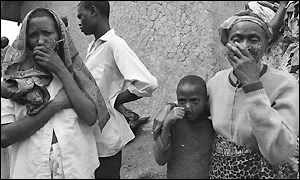Mass suicides by religious sects have not stopped since the events of Jonestown on November 18, 1978. In the late 1980s, the Movement for the Restoration of the Ten Commandments of God started in Uganda. Like Peoples Temple, the group began a strong emphasis on Christian practices, but added its own twist. A breakaway from the Roman Catholic Church, they emphasized practicing the Ten Commandments to their fullest, fasting frequently and banning soap and sex.
Both groups relied on the community-centered lifestyles in order to preserve their principles among their followers. By the mid-seventies, Jim Jones had leased land from the Guyanese government in order to create the Peoples Temple Agricultural Project. Although promoted as “the Promised Land,” a utopian community which the Temple would govern according to its own socialist principles, Jonestown became an isolated camp thousands of miles away from media scrutiny, governmental concerns, and interference – or even contact – by relatives. By the early 2000s, the Movement for the Restoration of the Ten Commandments of God had moved onto pineapple and banana plantations, filing a membership quota of at least 5,000 with the government. As both communities continued to grow, their leaders only gained more power.
Members of the Movement for the Restoration of the Ten Commandments of God reported speaking to the Virgin Mary through everyday objects; Jonestown residents left their wills to the USSR. In other words, both groups operated differently and for different ideology, but they both ended in death. Residents of Jonestown were called out of their dwellings on the final White Night and told that they must commit revolutionary suicide in order to escape their “enemies.” They were given Flavor-Aid mixed with potassium cyanide, which caused death in just minutes.
 Members of the Ugandan sect, however, went up in flames. After the original statement that the Apocalypse was going to occur on January 1, 2000 proved to be wrong, the five leaders of the cult stated that the world was actually going to end on March 17. On their final day, more than 500 people attended a party hosted by the leaders. Unknown to partygoers, the leaders had planned to blow up the facility where the party was held, killing everyone in attendance. Authorities who went to other Movement for the Restoration of the Ten Commandments of God sites discovered hundreds of burned bodies and destroyed properties, and the death toll eventually climbed to more than 700.
Members of the Ugandan sect, however, went up in flames. After the original statement that the Apocalypse was going to occur on January 1, 2000 proved to be wrong, the five leaders of the cult stated that the world was actually going to end on March 17. On their final day, more than 500 people attended a party hosted by the leaders. Unknown to partygoers, the leaders had planned to blow up the facility where the party was held, killing everyone in attendance. Authorities who went to other Movement for the Restoration of the Ten Commandments of God sites discovered hundreds of burned bodies and destroyed properties, and the death toll eventually climbed to more than 700.
The Christian foundations of both groups drew members in, and the sense of community feel made them stay. The Movement for the Restoration of the Ten Commandments of God preyed on their followers’ Roman Catholic background to make them feel as if joining the group would make them one step closer at making things right with God. Jones preyed on minority populations, offering Peoples Temple as a sanctuary and activist church, where they would not only feel welcome and safe, but where they could become involved in programs that would benefit the lives of their communities.
While these are only two examples of sect-related suicides, many others exist. The earliest known cult-related suicide dates back to the 8th century, when the Montanists – an early Christian offshoot – refused Emperor Leo III’s demand that they convert to full Christianity. Members of the sect locked themselves in their churches and lit them ablaze. More recent examples have been the Quebec-based Solar Temple, resulting in 74 deaths from 1994-1997, and the San Diego-based Heaven’s Gate, with 39 deaths in 1997.